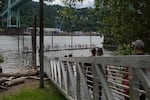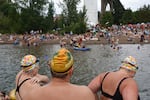Portland nonprofit Human Access Project held its first “Cathedral Park River Fest” on Saturday, in celebration of the park’s new dock. Organizers said it will hopefully start a new era where the public uses the park to recreate in the Willamette River.
Located just under the Cathedral Bridge in the St. John’s neighborhood, the dock is the culmination of years of efforts to increase access to the water for one of the more industrial parts of the city.
“All these people now are deputized to go back to their own communities and say, ‘You know what, I swam in the Willamette and it actually feels awesome,’” said Willie Levenson, founder of the Human Access Project.

Visitors enter the new dock at Cathedral Park in Portland, Ore., on June 29, 2024. The dock cost $900,000 and was partially funded by the local nonprofit organization Human Access Project.
Joni Land / OPB
The new dock cost $900,000 total, with the Human Access Project donating one third of that thanks to federal funding it received from the American Rescue Plan Act, which awarded billions of dollars to various nonprofit organizations.
Hundreds of people gathered at Cathedral Park on Saturday to take advantage of the new dock. Small children used it to cannonball into the water, while others used it to cast off their kayaks and paddleboards. The new dock also has swimming ladders for easier access to the water.
The previous dock was made of wood that had aged considerably over time. It also constricted waterflow, which led to an algae bloom forming at the corner of the dock. Levenson said the new dock floats on pontoons that create greater circulation.
“I’m hoping that this new dock design will mean that a harmful algae bloom doesn’t develop there anymore.” Levenson said.
The growth of dangerous blue-green algae in the Willamette has led to multiple warnings for people and animals to stay away from the river in previous years.
Related: Cooler temperatures and rain needed to wash away Willamette River algae bloom
Part of Levenson’s work, he said, is showing people that recreating in and around the Willamette is safe, if given the right investments.
“As more and more people get into the river, the parks department and other agencies will have more confidence that this is the type of investment that Portland wants in the city,” he said.
The Cathedral Park beach had long been uninviting to swimmers, both because of the aging dock and piles of concrete along the shore. Last year, volunteers removed more than 150 tons of concrete and rubble from the beach.
It’s part of the Human Access Project’s wider goal of creating more spaces for residents to use the Willamette River and its surrounding area for recreation.
“St. John’s deserves as nice of a river recreation experience as Sellwood,” Levenson said. “And this is a start.”

Swimmers stand on the new dock at Cathedral Park in Portland, Ore., on June 29, 2024. A celebration was held for the new dock, in part to increase interest in recreating in the Willamette River.
Joni Land / OPB
